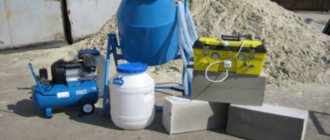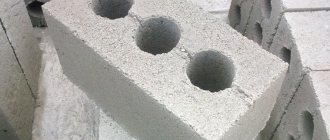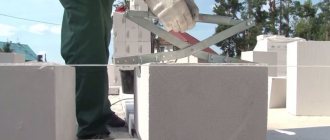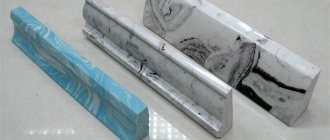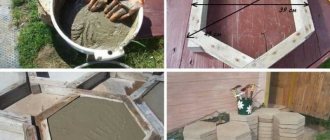Self-produced foam block
Making foam concrete with your own hands is increasingly gaining popularity among developers, because it is not only simple, but also profitable. With independent production, you can save up to 40% compared to the factory price, and thereby reduce the overall cost of construction.
In this article we will look at the process step by step and try to make sure that the issue is profitable. We will also understand the advantages of the material, which ensure high levels of demand for products.
So, the production of foam concrete at home: what are the features of the technology?
How to make foam concrete yourself
To create high-quality material, it is necessary to prepare special equipment and study manufacturing technology. It provides the following nuances:
To make foam concrete with your own hands, you can use the following technologies and methods:
- Autoclave.
- Simple.
- Non-autoclave.
- Using a concrete mixer and a foam generator.
When starting production, you should correctly calculate the proportions of the components, choose the optimal time interval for kneading, drying and holding in molds. If these rules are followed, foam concrete will be reliable and durable.
Instructions for making foam blocks
Work must begin with the provision of components, water and electricity. The area for storing finished products must be strictly horizontal. The finished liquid solution requires time to harden. Incorrectly established forms will result in a defect.
How to mix the mixture
Next, in order to properly make a foam block with your own hands, you need to follow the following instructions step by step:
- Sand, cement and water are loaded into the concrete mixer in the required proportions.
- The mixer is started until the desired consistency is obtained.
- Foam is prepared using a foam generator and foam concentrate. The degree of readiness can be determined by filling a bucket with foam and turning it over. If the composition does not spread, the foam is ready.
- Water and prepared foam are added to the concrete mixer. All this is mixed again for 3 minutes until a homogeneous mass is obtained.
Stirring for too long at this stage will lead to the destruction of the foaming agent. In the future, this will affect the quality of foam concrete.
Independent production method
First of all, sand and cement are placed in a concrete mixer. Then, using a special device and a foam concentrate, foam is created at a rate of 500 liters of foam per 1 m³. The cement mixture is diluted with water and mixed with foam.
After placing the components in the container, they must be thoroughly mixed. To change the density, different amounts of foam are added to the composition. The solution is poured into the mold and dried. Then the dry blocks are taken out and left to dry for 24 hours.
What are blocks made of - proportions of materials
Foam concrete products for the construction of private houses are made from cement, sand (crushed or natural), hardener and foaming agent. There are nuances here. The cement must be of high quality (grades M-400, M-500) without any foreign impurities. The recommended density of sand per cubic meter is 600 kg. You can reduce the cost of producing blocks. To do this, use screenings instead of sand.
It is easy to order a foaming agent at a store that sells building materials. You can actually prepare it yourself. You need to mix 60 g of wood glue, 150 g of caustic soda and 1000 g of rosin and heat these components. Heating is carried out until the composition becomes completely homogeneous in consistency. The hardener should be purchased ready-made. Doing it yourself is difficult and economically unfeasible.
To obtain one cubic meter of high quality foam concrete (with a density of at least 600 kg/cubic cm), it is necessary to take the components in the following proportions:
- sand (screenings) – 200 kg;
- cement – 320 kg;
- hardener - according to the manufacturer's recommendation;
- foaming agent – 1.2–1.5 l.
Water (use regular water from the tap) is added in an amount of 100–110 liters.
Stages of work
If you are interested in how to make foam concrete at home, you need to carefully study the technology for making foam blocks and find the optimal recipe. After this, you can perform the required actions step by step, strictly following the instructions.
Foam solution
Foam concrete technology involves the preparation of cement mortar. It is created in the same way as for traditional concrete. It is recommended to use products under the M400 or M500 brands as a cement mixture.
Foam is added to the finished solution. A foam generator is sold in every hardware store or made from improvised materials.
Pouring solution into molds
The next stage is to pour the prepared consistency into prepared forms. Before performing this action, the containers are lubricated with a special solution. Builders know 2 methods of how to make foam blocks with their own hands:
- Molding.
- Cutting.
Cutting technology
After the event is completed, the container with the blocks is placed in a place to dry. After 12-24 hours, depending on the effectiveness of drying, the foam block is removed from the pallet and moved to the storage location.
The technique has the following advantages:
- The geometry of the blocks is smooth and correct.
- The edges have no deviations.
- Any chips or irregularities are excluded.
The disadvantages include:
- Additional costs for purchasing equipment.
- If the concrete does not harden, it will be destroyed when cutting.
Kawabanga! Concrete cutting saws
Comparative analysis
Having considered the production of foam blocks at home, it would be correct to consider their difference from ready-made factory blocks.
Foam concrete blocks produced in production are characterized by precise geometry
Differences between a factory unit and a home unit
It's no secret that factory construction shops use professional equipment. The quality standard of factory blocks from our own products will differ in the following points:
- the factory block has better geometry, which makes it possible to reduce the layer of masonry and, as a result, increase the frost resistance of the entire structure;
- factory units are additionally checked by a special regulatory body;
- factory blocks are lighter and shrink less.
Comparison of foam concrete with other building materials
Before starting construction, every developer is faced with the problem of choosing building materials. And it is difficult to make, because today there is a wide range of materials on the market: brick, aerated concrete, foam concrete, wood. Therefore, we will consider the distinctive properties of foam blocks with different building materials. This is best done in tabular form.
| Building material/Characteristics | Foam concrete | Expanded clay concrete | Aerated concrete | Ceramic brick |
| Density, kg/m3 | 300-1200 | 400-2000 | 300-1200 | 1400-2100 |
| Frost resistance in cycles | 25-100 | 25-200 | 25-150 | 25-300 |
| Thermal conductivity, W/(m*S) | 0,07-0,4 | 0,14-0,5 | 0,08-0,38 | 0,56-0,7 |
| Shrinkage | No more than 1 mm/m2 | Not affected | 0.3-0.5 mm/m2 | No more than 10% |
| Water absorption,% | 15 | 18 | 25 | 5-10 |
Foam concrete production - mixture composition
Building materials are obtained with different strengths depending on the proportions of the components included in the composition:
- Portland cement is needed as a binder.
- Medium and fine sand should consist of ¾ quartz and with less than 3% impurity level.
- For foaming you will need a foaming agent, synthetic or natural.
- Water.
To produce 907 kg of raw foam concrete mixture with a density of 800 kg/m³ you will need:
- 420 kg of sand;
- 320 kg of cement;
- 140 l of water in solution;
- 1.2 kg of foam concentrate.
The composition of the material may vary depending on the purpose. For the first row, you can make stronger and heavier products. Lightweight and less thermally conductive blocks are suitable for the upper rows.
Foam concrete is a modern material with a lot of operational advantages
Due to a number of unique properties, foam blocks are ideal for the construction of low-rise buildings. Foam concrete products are characterized by:
- Highly environmentally friendly. They contain exclusively natural, completely safe components.
- Excellent thermal insulation potential. The blocks consist of cellular concrete filled with air. This structure of the material does not allow heat to get inside the house in summer and does not release heat outside in winter.
- Easy to install. Foam blocks are easy to process, cut to specified sizes and installed with your own hands.
- Operational reliability. The material is not afraid of chemical influences and resists precipitation well.
- Fire safety. A partition made of 15-centimeter thick foam blocks does not catch fire for 3–4 hours.
- Increased strength and low weight. The weight of foam concrete products is 2.5 times less than that of standard bricks. Due to this, minimal load is placed on the base of the building. You can save a lot of money on building a foundation. And the high strength of foam blocks provides a compressive load of up to 100 kilograms per cubic centimeter.
Foam concrete is notable for its increased strength and low weight.
Also among the advantages of foam concrete, we note its excellent sound insulation and increased fluidity rate. Thanks to the latter property, the process of making such blocks with your own hands is simplified and becomes accessible to most home craftsmen.
Making a foam generator
Before making a foam generator for foam concrete with your own hands, you need to study the principle of its operation:
Next, the foam needs to be fed into the concrete mixer to form foam concrete.
3 knots
The foam generator includes the following main subsystems:
Scheme
The device diagram must include:
- a dosing module, most often consisting of valves that regulate the amount of foam mixture and air;
- tee or mixing chamber;
- Laval nozzle or jet;
- foam cartridge.
There are more complex variations of circuits, including a container, pipes and hoses, a compressor unit, as well as additional converter structures - a diffuser, a check valve with a suction pipe, a connecting flange and a weight.
Assembly - drawing
Depending on the type of device used, the assembly drawing should show:
Manufacturing
The density of the foam and other indicators of its quality depend on the choice of design and correct assembly of the generator, which must ensure accurate mixing of the building mixture, water and air.
Materials and tools you will need:
Making a mixing chamber
You will need to take the prepared pipe and weld 2 pipes to it:
- Air is most often supplied from the end.
- The foam concentrate emulsion is connected at a 90° angle, and some designs use a 45° angle.
To make a more reliable device, 2 taps are installed in each of the pipes (side and end):
- adjusting - to change the quantity, pressure, supply pressure;
- shut-off, allowing, if necessary, to completely shut off the flow.
Kawabanga! Chisels for concrete hammer drill
2 valves are installed so that after making adjustments to the quality of the foam, they are not knocked down every time the device is turned off or the supply is stopped.
The mixture pipe is made larger than the air pipe by 20%.
Making a foam cartridge
To release the finished mixture, a special pipe is welded to the 2nd pipe blank.
To limit the rate of foam release, a diffuser is made in the nozzle - a funnel.
The mixture is converted into foam using mesh filters. In home designs, they use ready-made filters or a cheaper, but no less effective option - meshes, which are made for cleaning kitchen utensils.
You need to take metal wire mesh and fill the pipe with it along the entire length, doing it as tightly as possible.
Plastic pipes produced for sewer systems can be used as a housing for the foam cartridge. Often the end “Ruff” is not used, but various limiters are installed to prevent the mesh from falling out.
Connection of mixing chamber and foam cartridge
The foam cartridge must be connected to the end with the mixing chamber. A jet washer or Laval nozzle is placed between them, which serves to increase the speed of movement of the mixture through the foam generator.
The use of a nozzle increases the efficiency of the system by 30-40%. Do-it-yourself Laval nozzles have round metal plates with many small holes.
The jet option is cheaper, easier to find and install, and can be used as a temporary measure. It, like the Laval nozzle, is placed in front of the foam cartridge after the mixing chamber (tee).
The most common parameters for a Laval nozzle:
- hole diameter in the center - 10 mm;
- the output diameter relative to the depth is made 3:1;
- the ratio of inlet diameter to depth should be more than 30 mm (1:1).
The optimal dimensions of the foam cartridge, which is made to produce up to 500 liters of foam, are 600-800 mm in length and 50-80 mm in diameter. For smaller volumes (up to 200 l), the cartridge diameter is made 30-40 mm.
Compressor connection
The foam concrete unit includes a compressor, which can be of any design, but with a pressure of about 6 atmospheres.
If the capacity of the foam generator is a tank with a volume of 200 liters, then instead of a compressor you can use a pump with a pressure of 2-3 atmospheres.
Connecting the container
The tank containing the foaming agent must be connected to the side pipe connected to the mixing chamber.
The container is usually installed on a frame with wheels for easy movement on site. It is connected to the side pipe using a flexible hose, through which the foam emulsion enters the mixing chamber.
To produce a large volume of product, a small additional pump is connected to the container to facilitate more efficient supply of the emulsion. But they often leave the system running on its own.
During installation, all parts of the foam concentrate must be connected securely and tightly. For this purpose, gaskets, sealing couplings, Fum tape, etc. are used.
A self-made foam generator for foam concrete will cost less than one bought in a store. The blocks made from the foam he produces will not differ in quality.
House made of foam concrete
When constructing low buildings, foam concrete can be used not only in the form of blocks. Today, houses made of monolithic foam concrete are especially popular, when the mixture is gradually poured into the formwork. A house made of foam concrete can be built within a month. It will be durable, with smooth walls and a minimum number of temperature bridges.
Using monolithic foam concrete made by yourself will reduce time costs and save money on production. Monolithic foam concrete can be found:
- for frame house construction, for the construction of walls and ceilings;
- creating floor screeds;
- thermal insulation of the roof, attic or attic;
- possible thermal insulation of long-distance pipelines;
- filling voids formed during tunneling.
The construction of houses made of foam concrete involves a thorough study of the entire process and a number of features. Before pouring foam concrete, preparation is carried out. First you need to build a frame, install formwork, lay an electrical cable, and install ventilation ducts. The foundation is not created from foam concrete and this is clearly stated in SNiP II-22-81.
Construction methods
There are different ways to build a house from monolithic foam concrete. Each of them has its own characteristics and advantages. The main difference between all methods is the type of formwork, which can be removable or permanent.
Brick permanent formwork - load-bearing walls are built from bricks, between which the mixture is poured. In this case, foam concrete acts as insulation, so low-density grades can be used. The formwork system is strengthened by vertical reinforcement and the addition of fiberglass during the production process.
Filling walls with foam concrete in this way allows you to immediately carry out their internal and external finishing, since you do not need to wait until the concrete inside the formwork has stood. This significantly increases the construction time of the building and proves that monolithic foam concrete in permanent formwork is more economical and easier to work with than reusable forms for foam blocks.
The use of polystyrene foam hollow blocks is reminiscent of LEGO construction sets
The construction of houses from monolithic foam concrete can also be carried out using a heat-conducting profile. Load-bearing metal structures are installed under the pouring. They are needed to maintain the formwork, which can be removable or permanent. The roof can also be cast from foam concrete. The following materials are used for permanent foam concrete formwork:
- cement bonded particle boards;
- plywood;
- OSB sheets.
In addition to these methods, you can use a composite. In this case, the outer part of the formwork is made of facing material, and the inner part is made of panels. The panels can be dismantled after work. With this approach, there is no need for costs for facade work, which will speed up the construction process.
To save money, sheet material can be used for the entire formwork and poured gradually. But in this case, you will have to dismantle and rebuild the formwork each time, which is inconvenient, increases time intervals and violates the solidity of the structure. Nevertheless, this method deserves attention, as it will be the least expensive.
It is easy to see that using permanent formwork is the easiest and fastest way to build walls for a house. But it is worth highlighting one more material for monolithic construction. This is the use of hollow blocks based on wood concrete, also known as wood concrete. It can be used not only for pouring porous filler, but also ordinary concrete.
Advantages and disadvantages
It is worth understanding that if everyone used monolithic foam concrete in the construction of walls, then other materials would have long since become a thing of the past. Therefore, it is obvious that this method of construction is not always relevant. But first, here are the main advantages of this method:
- safe for health, because environmentally friendly material is used;
- low cost;
- allows air to pass through well;
- high sound insulation;
- easy to handle;
- high levels of thermal insulation and moisture resistance;
- low costs for fittings.
The disadvantages of a house made of monolithic foam concrete include:
- impossibility of construction in winter;
- fragility of the material under point load;
- the need for strict adherence to the rules for preparing the mixture and pouring it;
- possible appearance of cracks during shrinkage;
- small number of frost resistance cycles.
For what purposes do you use foam concrete and have you had experience working with it? We invite you to share this in the comments.
Composition and varieties
The types of foaming agents directly depend on the composition of the concentrate. Foam formers are found:
- organic;
- of synthetic origin.
Foam concrete blocks made from protein concentrate meet high quality standards.
But practice shows that a lot of foam does not always mean good quality material. This is evidenced by craftsmen who tried to make a foaming agent from soap with their own hands.
